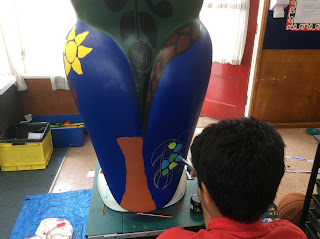For many young people talking about their art comes naturally. For others it is a struggle. For many of the students I am teaching this year, talking about their work, their feeelings' or their opinions can be quite challenging. I am going to follow a few students throughout the year and record them talking about their art and the process involved. I am hoping as they become more confident in sharing among their small group the discussions will become more detailed and richer language forthcoming.
I am also hoping their conversations will encourage others in the class to share their thoughts and become involved in open classroom discussions. The 5 students I have chosen to be my leaders will eventually lead their own small groups in discussions.
To set it off I planned an art lesson to paint Omaru Creek in water colours. We had been walking past Omaru Creek for two weeks on our way to swimming lessons. We would stop and talk about how dirty the creek was and what was causing this. We had many interesting discussions about the wild life living in Omaru Creek. I was hoping this would follow through to my art lesson.
My lesson was a complete disaster. The students were not listening to my instructions, talking the whole time and been incredibly silly with the paint. I could feel myself getting frustrated. I should have stopped the lesson right then but unfortunately I carried on and the lesson soon deteriorated into complete chaos. The whole point of this lesson was to get them talking and to introduce them to new rich language. For once they had finished their painting, their task was to write a narrative and Omaru Creek was to be the setting.
I sat back at lunchtime and thought, what happened? How did it go so horribly wrong?
Then I thought of the grouping. First mistake. I had all the top writers with me. I had done this on purpose as these students have a different writing plan to the others. These students are chatty and full of confidence and I thought this would generate amazing discussions. Second mistake. I had let them sit wherever they wanted. If I don't let students sit on the mat together because they talk too much, what on earth was I thinking letting them sit together to do art.
Even if we accomplish nothing else in a school day, the least we can do is demonstrate a respectable level of self-control. Part of our job is to show students how to handle anger, stress, and conflict in a healthy and productive way. We can’t just tell them to do that. We have to show them. And yelling is definitely not showing them healthy, productive stress management.
So my art lesson turned into a self discovery of how I could have handled this situation better. I did eventually stop the lesson and the students packed up the paint and cleaned the tables in complete silence.
I don't know if I will attempt to do this lesson again. I think it is marred now with negative energy. I love teaching art, it is my passion, so one bad lesson will not put me off. Instead I did learn a valuable lesson myself. It gave me time to reflect on my own practice. Was I expecting too much from them? Were my instructions not clear enough? Was I giving them enough time to follow one instruction before giving them another?
What I do know is this. When a child puts their heart and soul into an art project—and spends hours working on it, cultivating it, and making it beautiful—they'll feel an enormous sense of accomplishment when it’s complete. The arts are a great leveler, as we are all in the same boat, learning to create and succeed in new and unexpected ways.





















